Justin’s excellent article on the Universal Revolver Reload (URR) raised a question from a RevolverGuy seeking suggestions for how he could avoid burning himself on the forcing cone of his revolver when executing the reload. He’s not the first to encounter this difficulty, and fortunately, there’s an alternative technique that can help: the StressFire Revolver Reload.
Ring of fire
It’s important to note that the URR is an excellent technique, and not everybody suffers from getting burned on the forcing cone when they use it (or a similar technique that puts fingers inside the cylinder window) because there’s a lot of variables involved.
A medium-to-large frame gun offers lots of room inside the cylinder window for a person with thin fingers to grasp the cylinder and avoid the area near the forcing cone, but that same gun might put the guy with sausage fingers in jeopardy of a little BBQ action. If you shoot a little J-Frame sized gun, then you might get burned too, no matter how thin your digits are.
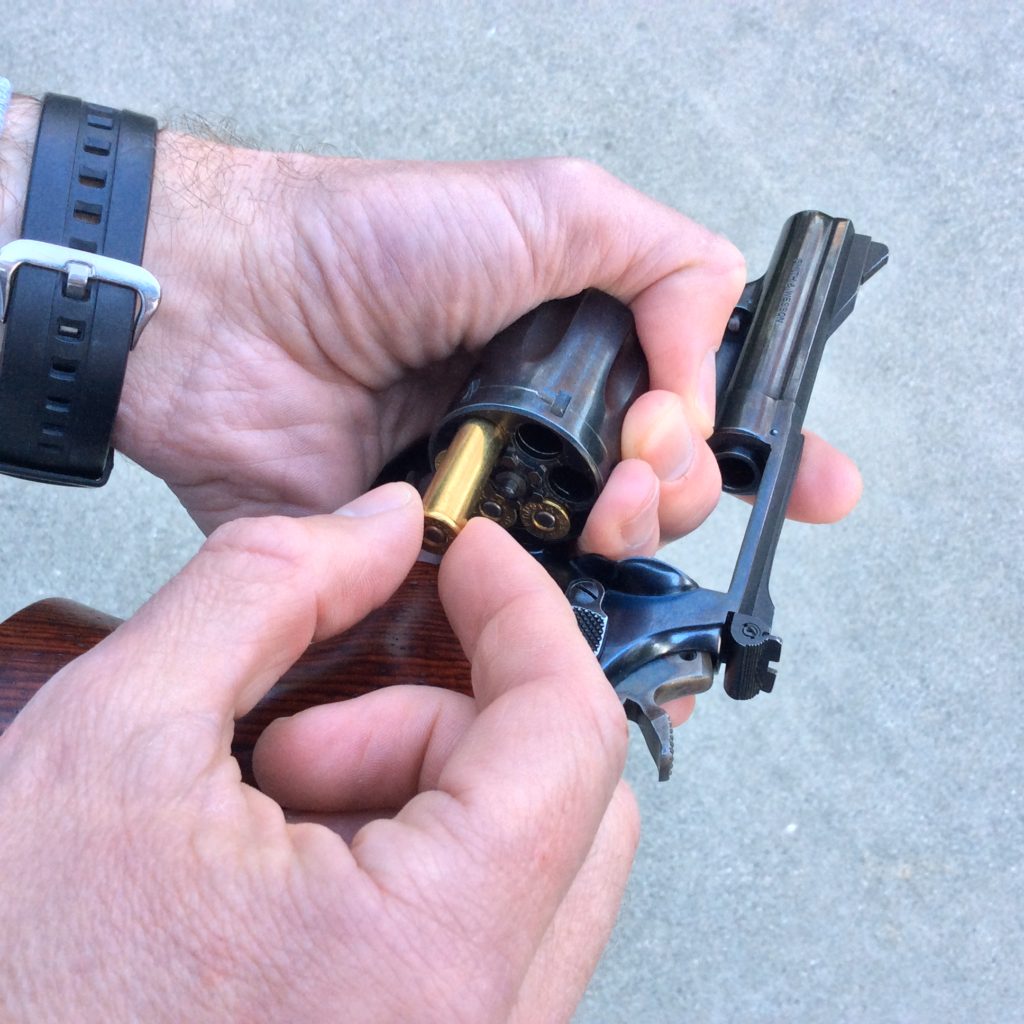
If your pace is leisurely, you might never heat up the gun enough for it to be a problem. However, high volume, rapid fire shooting (such as training) will definitely improve the odds of getting a blister on your booger hook, because the gun can get heat soaked. This is especially true if you’re shooting a small frame gun without a lot of material to absorb the heat, or are shooting a steady diet of the fire-breathing Magnum cartridges that Justin favors in his guns!
Even if everything normally runs in your favor, a hurried or poorly-executed reload could find you putting your hand closer than it normally is to the forcing cone, earning you a reminder not to do that again.
Disco Inferno
Back in the 1970s and early 1980s, the increasing popularity of .357 Magnums in police work exposed a few weaknesses of traditional reloading methods. The 35,000 PSI pressures of the .357 Magnum (or even the 23,500 c.u.p. of the .38 Special +P+ loads) far exceeded the 17,000 PSI pressures of the standard .38 Special, and made the empty cases more difficult to extract after the rounds had been fired. When the widely-popular “FBI” technique was created in the 1930s, working the ejector rod with the tip of the weak hand thumb did a good job of kicking spent .38 Special cases out, but the technique began to fall apart when the thumb struggled to break the grip of the high-pressure Magnum cases on the cylinder.
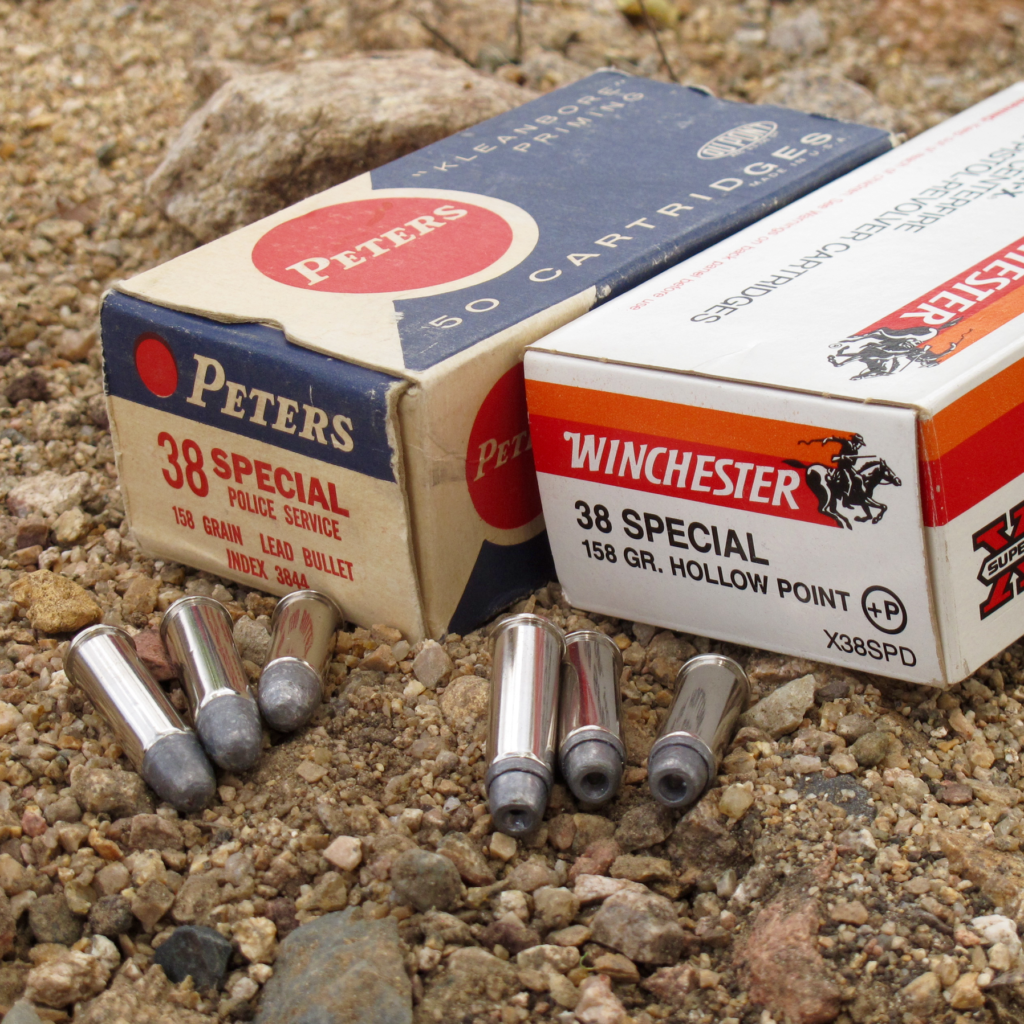
The greater volume of high pressure gas generated by the Magnum cartridges also heated up the forcing cone of the revolver faster than the more sedate .38s, making accidental burns more likely when the FBI technique was used to reload the gun.
A better widget: The StressFire Revolver REload
To alleviate these—and other—weaknesses in reloading techniques, my friend Massad Ayoob developed a unique technique for reloading the revolver as part of his StressFire system. He introduced the technique to the public in his StressFire book, circa 1984, and taught it far and wide to police and armed citizens alike through his writing and through classes at his Lethal Force Institute. I first learned the Stressfire Reload from Mas’ book, but in 1997 I got to refine it as a student in his flagship course, LFI-I (now, MAG-40), shooting a Model 640 and a Model 65.
The StressFire revolver reload minimizes the dependence on fine motor skills, and uses a powerful, gross motor-type† movement to operate the ejector. It also takes advantage of natural biomechanics to hold the gun in a pure vertical orientation for unloading and loading, which allows gravity to assist with the ejection of spent cases and the loading of cartridges.
Let’s take a look at how to execute a StressFire revolver reload from the perspective of a right and a left-handed shooter.
StressFire: Right Hand
Starting with the gun on target, use the right hand thumb to operate the cylinder latch, and push the cylinder out of the gun with the fingers of the left hand. Keep the gun in your right hand, and move the right thumb out of the way so that it’s clear of the rear of the cylinder. Most shooters will be able to use the thumb to hold the cylinder in the open position, by placing it on top, around 12 to 2 O’Clock.
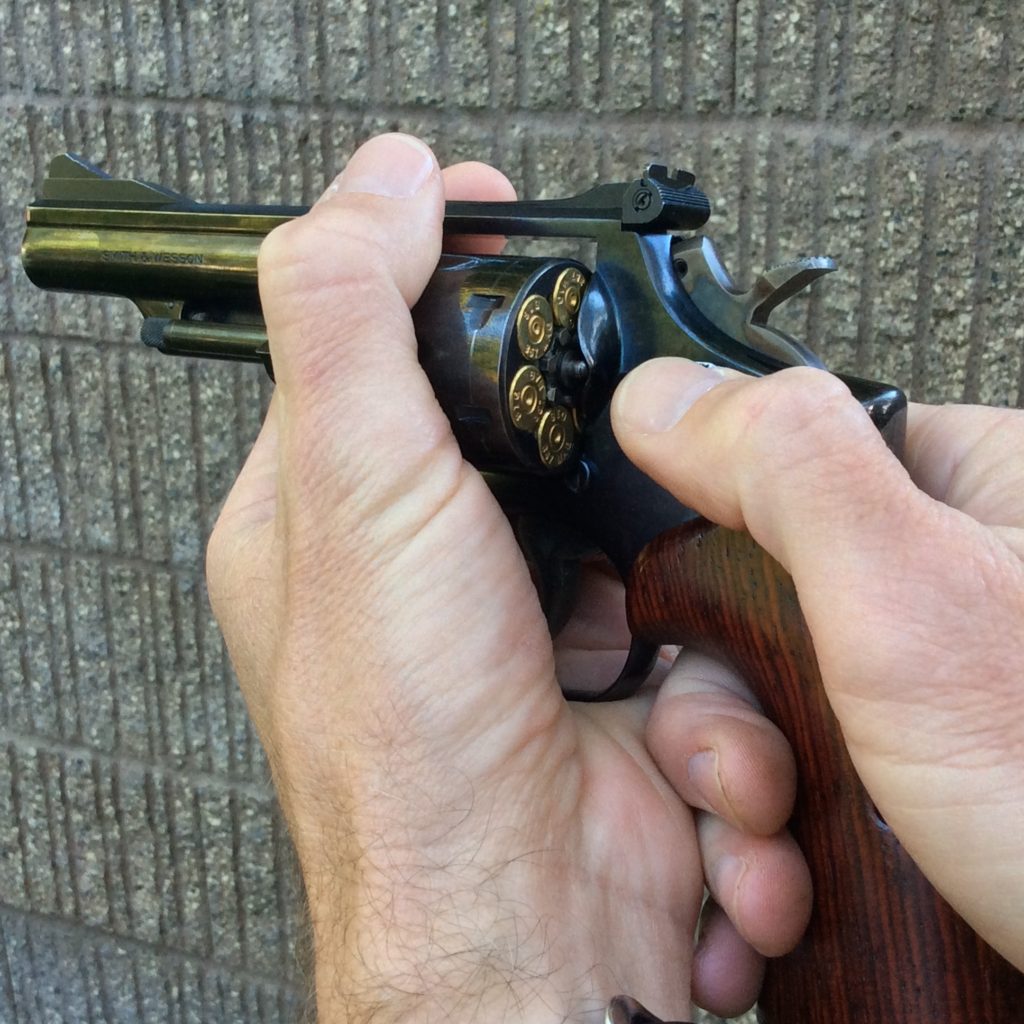
Rotate the gun so that the muzzle is pointing straight up towards the sky. Orienting the gun in this manner will help the spent cases fall free from the cylinder when the ejector rod is worked. It will also allow other debris (unburned powder flakes, soot) to fall free from the gun with less risk of it getting trapped behind the extractor star, which could prevent you from closing the cylinder.
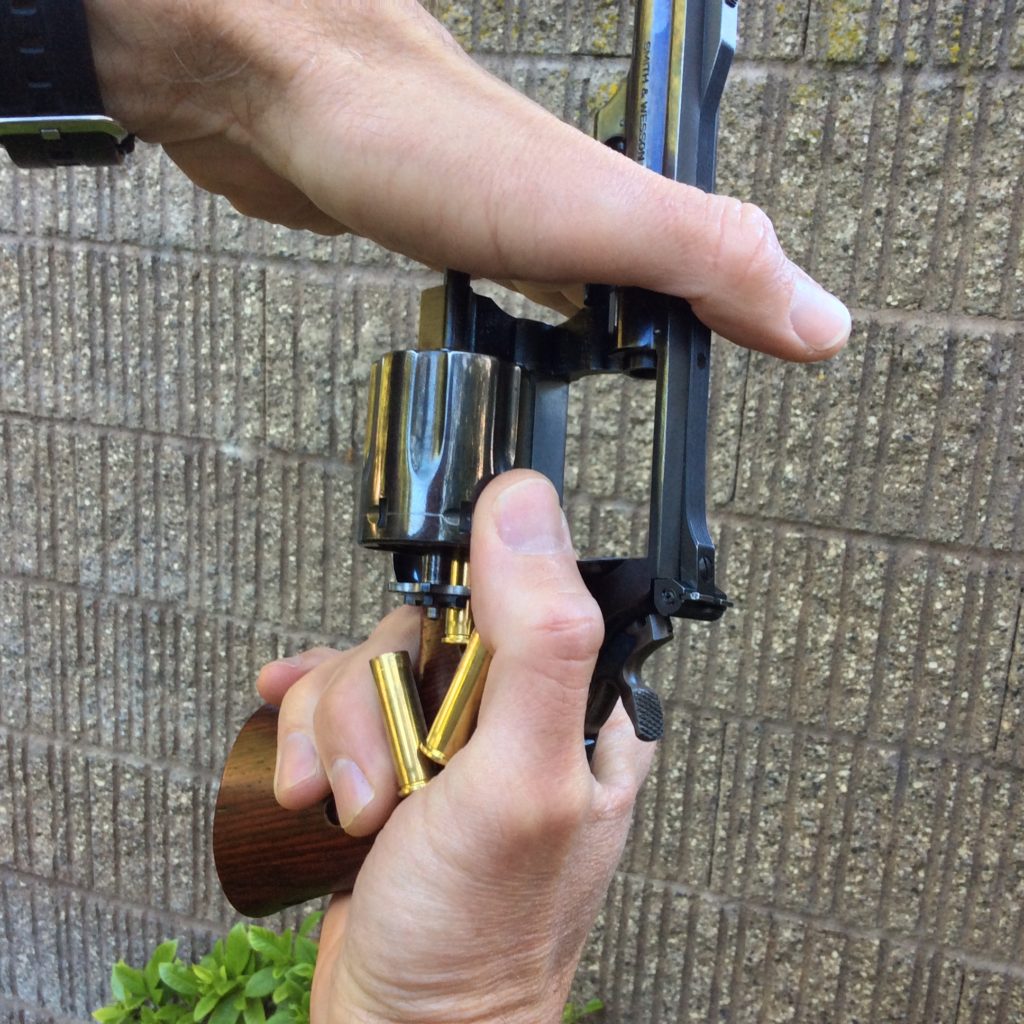
Keeping your right hand free of the area behind the cylinder, use the palm of your left hand to strike the ejector rod once in a sharp manner. If you have a service-sized gun, you can place the web between your left thumb and index finger against the barrel, and let the barrel guide your palm straight down onto the tip of the ejector rod. Doing so will help to ensure that you hit the rod squarely, and not at an angle which would rob your strike of its power, or potentially bend the ejector rod (which could prevent the cylinder from rotating).
It’s useful to note that since your right hand is on the grip of the pistol and out of the way, your palm strike of the ejector rod will be unimpeded, helping to guarantee a full throw. This is not the case in many competing techniques, which use the left hand to hold the cylinder, and the right to strike the ejector. It’s also important to note that the ejector rod should not be “pumped.” One firm strike will move the ejector rod its full length, and deliver enough force to kick the empty cases free. If you try to pump the rod, you run the risk of not pushing it down all the way, and getting a spent case trapped underneath the extractor star. You’ll also waste time.
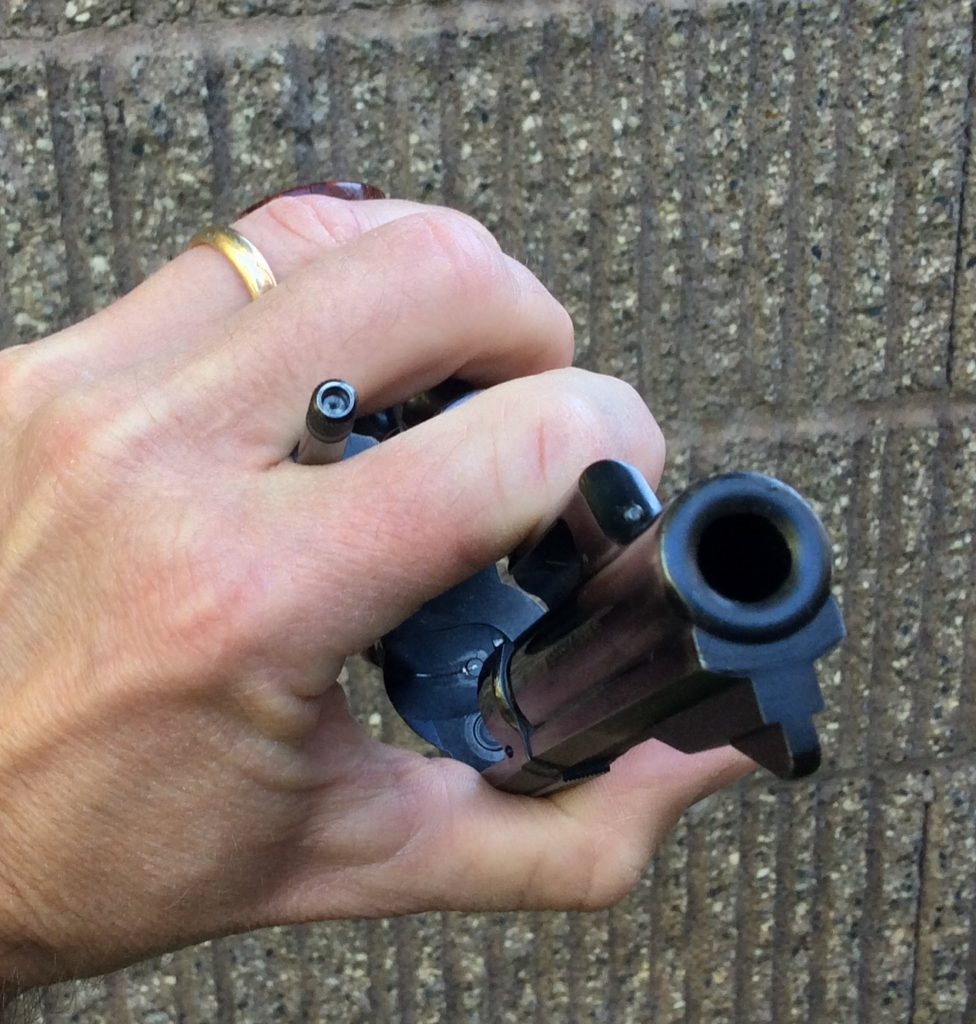
When the left hand comes off the ejector rod, open up the area between your left index finger and middle finger to form a “V.” The left hand will come back down and grasp the cylinder with the ejector rod going between the fingers in this “V,” and the face of the cylinder in the palm. The fingers and thumb of the left hand will close around the sides of the cylinder, cupping it. If you miss the “V,” that’s OK—the technique will still work with the ejector rod poking out between other fingers, or even between index finger and the thumb.
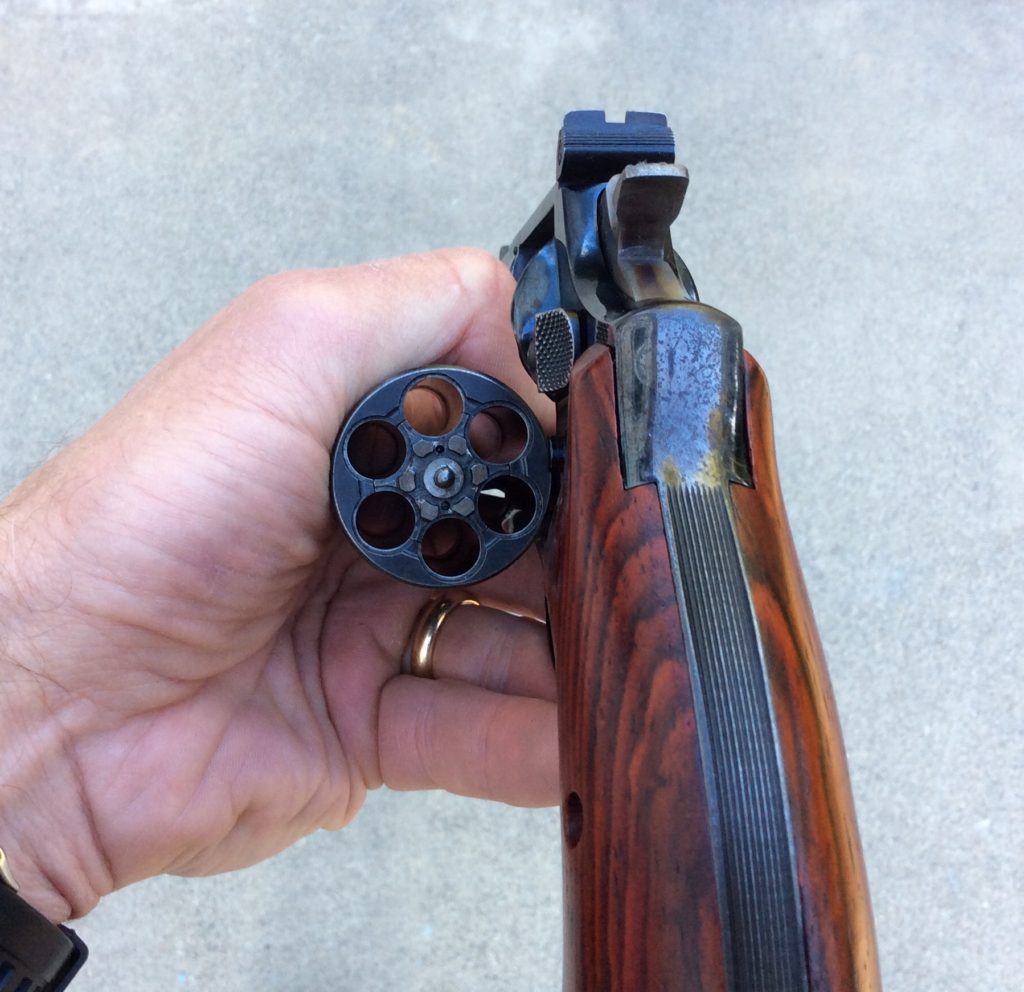
Now, release your grasp of the gun with your right hand, invert the gun, and point the muzzle straight down at the ground. Placing the butt of the grip against your belly will provide a good index and help to orient the gun properly. Your left hand will be cupping the cylinder and holding it open, ready to accept cartridges from the right hand. The pure vertical orientation of the gun will maximize the opportunity for gravity to do its job in seating the cartridges.
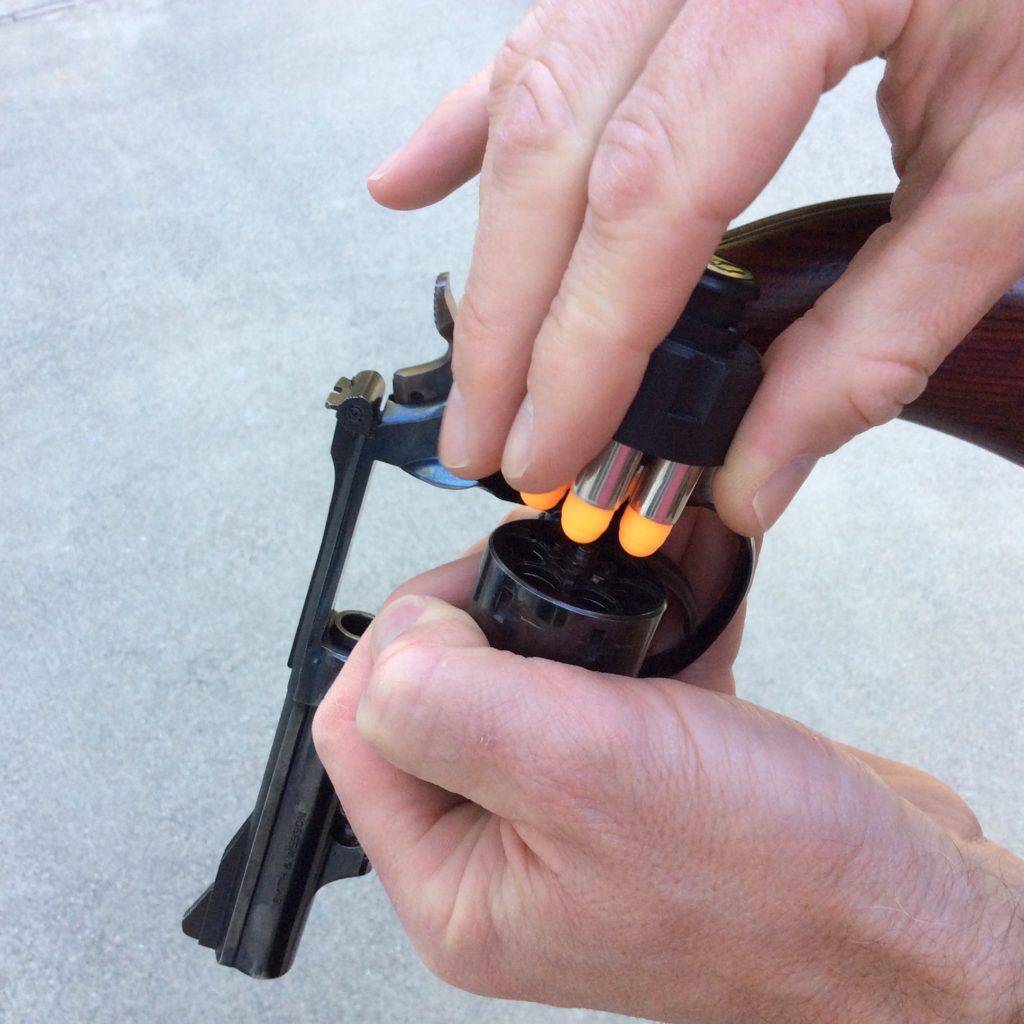
After the cylinder has been loaded, assume a firing grip on the gun with your right hand. Push the cylinder closed with the base of your left thumb, and move your left hand to assume a two-handed grip on the revolver. If you used a speedloader, it should fall away on its own, without any extra help from you.
StressFire: Left Hand
The left-handed version of the StressFire revolver reload is slightly different.
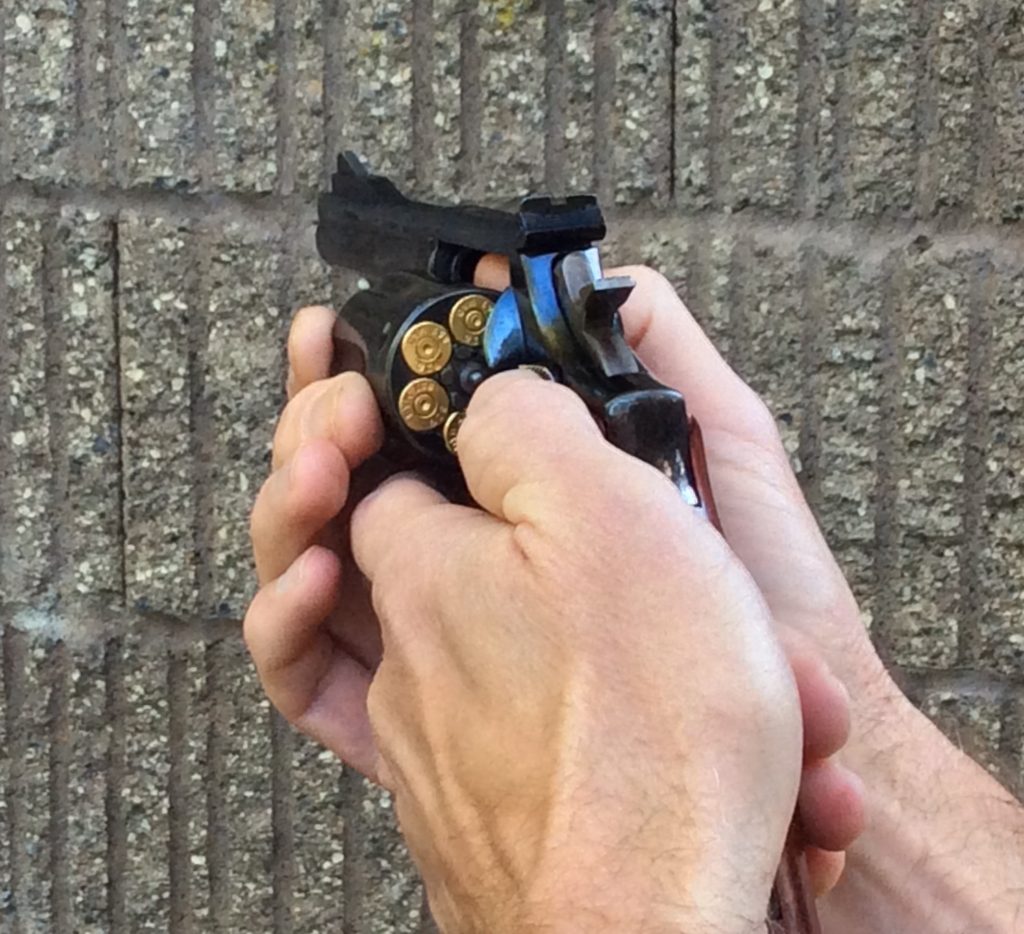
Starting with the gun on target, use the left index finger (easiest for Colts) or thumb (best for Smiths, Kimbers and Rugers) to work the cylinder latch, as the right thumb pushes open the cylinder. The right thumb continues through the frame and wraps over the top of the cylinder, as the fingers of the right hand cup the cylinder face and the frame, with the ejector rod poking out between them (usually between the index and middle finger on the right hand).
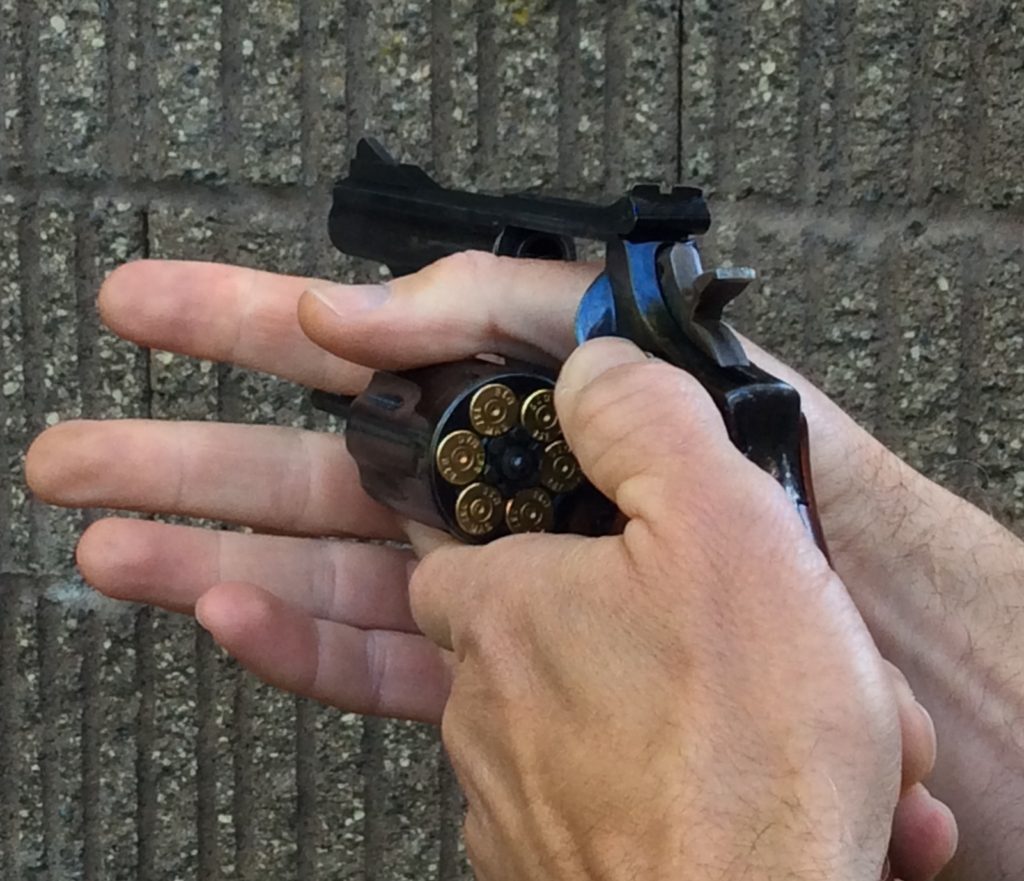
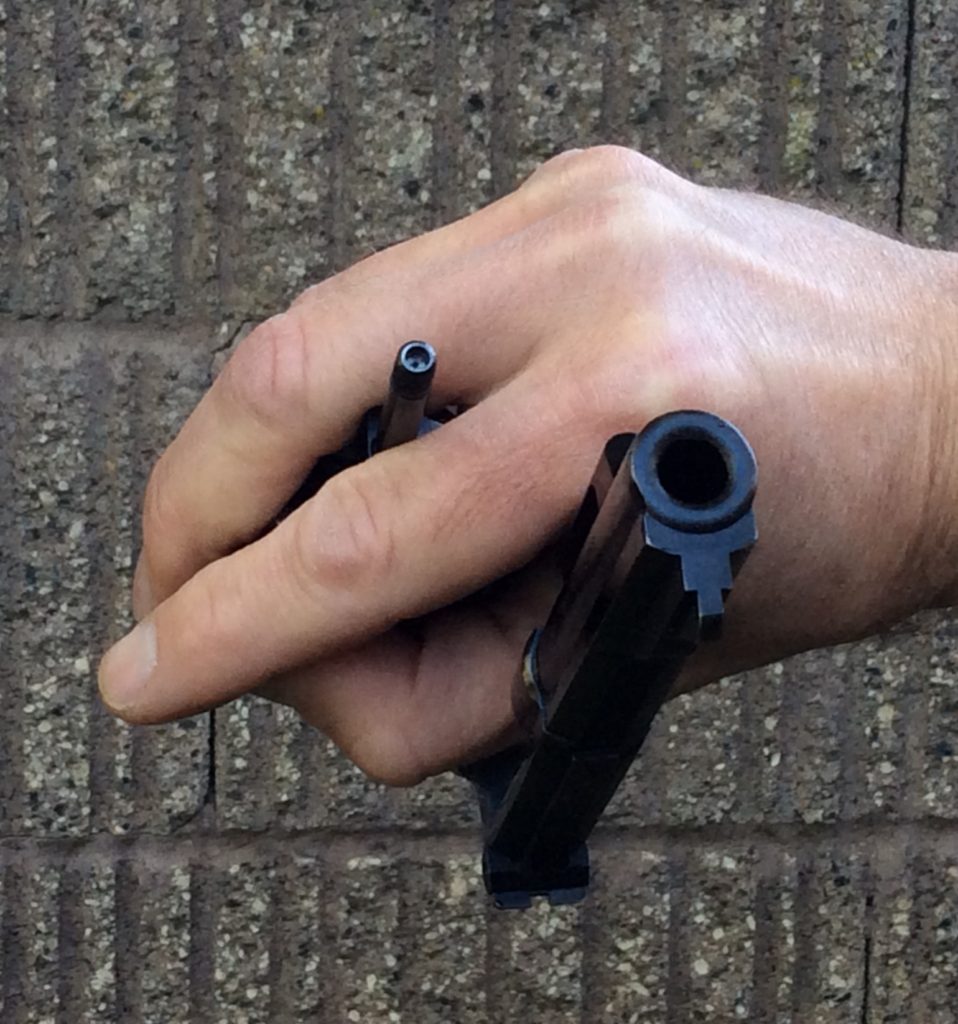
Once the right hand has control of the gun, release your grip with the left hand. Rotate the muzzle straight up toward the sky, and strike the ejector rod with the palm of the left hand as described above. Note that the fingers of the right hand may interfere with a full throw of the ejector rod in the sinistral version of the StressFire, so give the ejector rod a firm slap to throw the spent cases free.

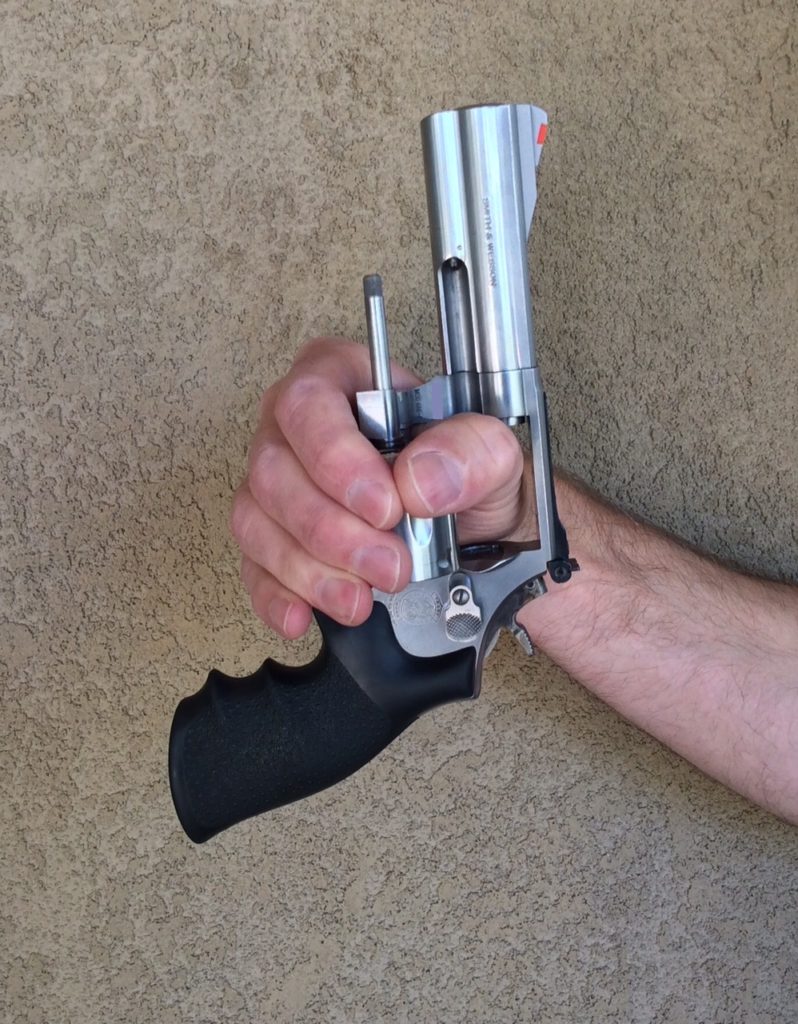
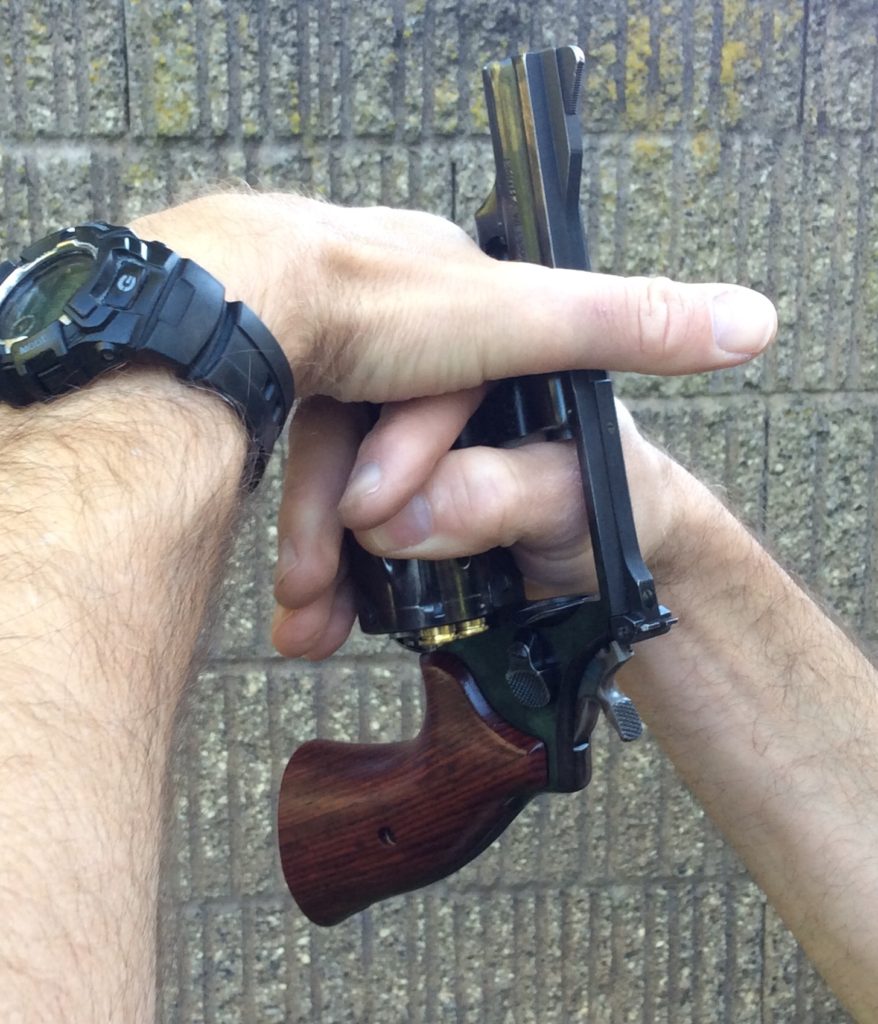
Once the spent cases are ejected, rotate the gun muzzle down, and place the butt of the weapon against your belly as an index. The cylinder is still being cupped by the right hand, which holds it open to accept cartridges from the left hand. Once again, the pure vertical orientation will allow gravity to do its best work.
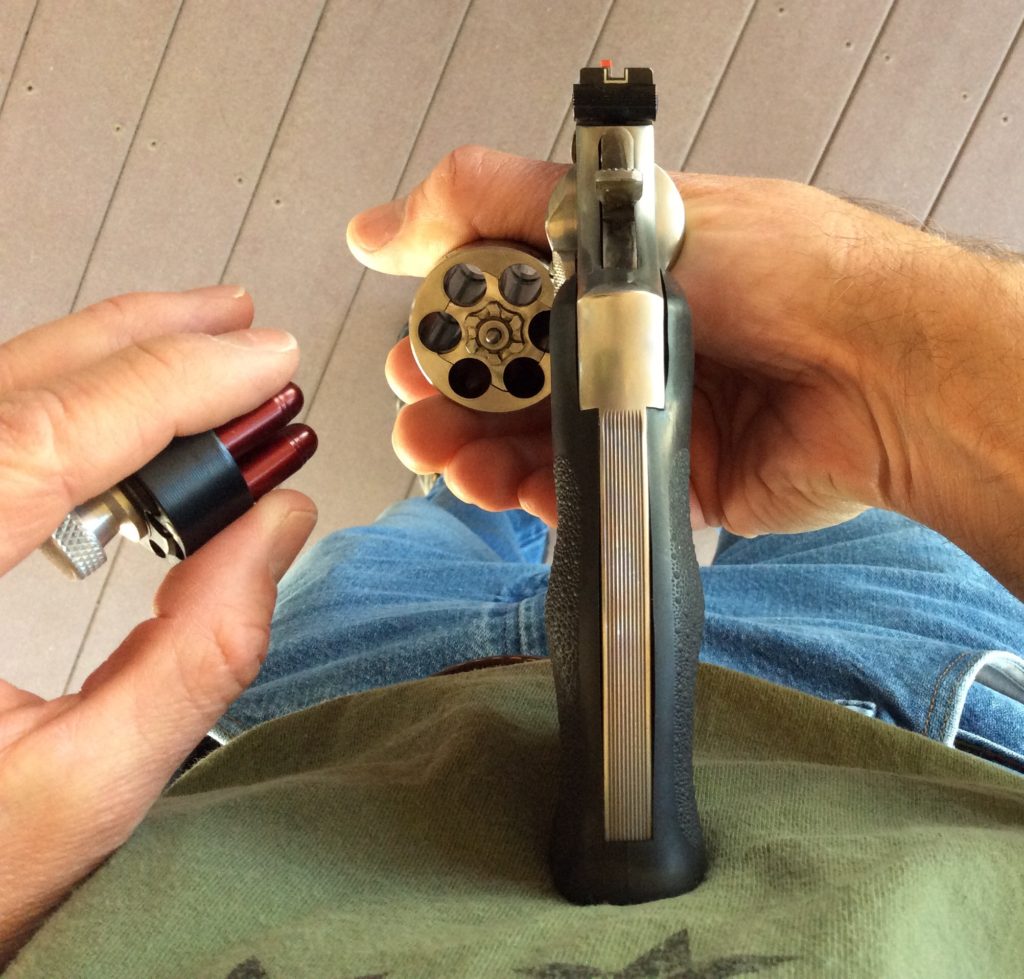
After the cylinder has been loaded, assume a firing grip on the gun with your left hand. Push the cylinder closed with the fingertips of your right hand, and move your right hand to assume a two-handed grip on the revolver. If you used a speedloader, it should fall away on its own after you release it from your left hand.
You pays your money . . .
The choice of how you load your revolver is up to you, but the StressFire revolver reload is definitely worthy of your consideration. We’ve discussed several of the benefits along the way, but the strongest one in my opinion is how easy it is to keep the gun in a purely vertical orientation for ejection and loading. When I use other techniques, I tend to hold the gun at an angle (particularly for loading) which robs gravity of some of its effect. In contrast, the StressFire revolver reload makes it easy to hold the gun straight up and down. This is a huge benefit for those of us using gravity-feed speedloaders, like the popular Safariland Comp-series loader.
So, if you’re concerned about burning your hand on the forcing cone with other methods, give the StressFire revolver reload a try and let us know what you think. Even if your gun isn’t branding you during reloads, give the technique a try and see what it has to offer. I think you’ll find a lot to like there.
†Note from Justin: Mike is using the correct terminology here in referring to a gross motor-type movement. The misuse of “gross” and “fine” in regards to motor skills is rampant in the firearms industry. Gross motor skills are those that involve large movements of the arms and legs (running, jumping, punching), while fine motor skills are anything involving small movements of the hands, wrists, feet, and toes (holding a fork, typing, loading magazines). While some will turn up their nose at using the slide release‡ because it is a fine motor skill, they disregard the fact that the “power stroke” or “slingshot” or [fill in the blank] is also defined as a fine motor skill.
‡Still others will get mad at me because I called it a slide “release” instead of a slide “stop”. Sometimes you just can’t win…

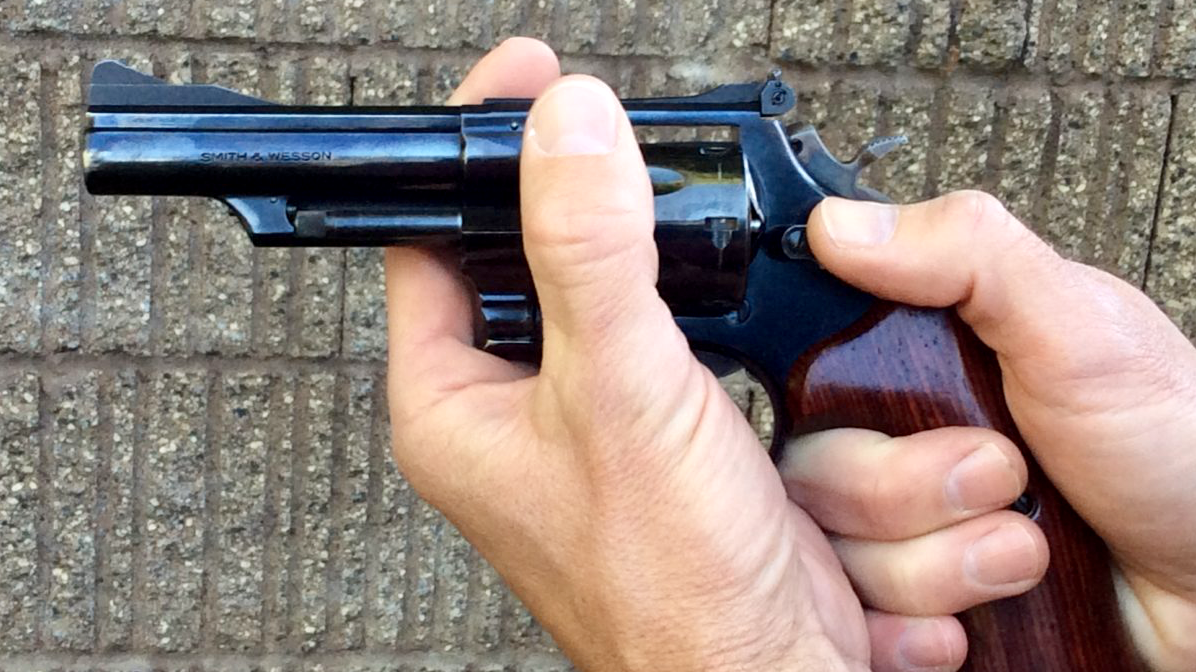
Mike, how on earth did you take that last picture with both hands in view??!? Not that I would dare take a picture myself from the same angle, no one I know would care to see the amount of belly I’ve put on…
More seriously, thank you for illustrating this technique for us! I have seen a video of Ayoob performing it but this is clearer somehow.
Given the 686 with Hogue grips, I suspect Justin took the last picture. If I had to do that, I would use a tripod with the camera at what we see as the top of the picture. That would cause the picture to be upside down, so you would then have to rotate the image, but that is the easiest solution I can think of.
Haha! Let’s just say I had help and the whole process brought monkeys and footballs to mind, Riley!
Greyson, I wish you had been there to suggest that. Next time, I’ll call you first, for advice!
LOL, I was imagining a third hand sprouting!
Thanks, Mike, for yet another excellent article.
Appreciate your use of pictures to make it all clear.
Glad it helped, Bill!
Great article. I had never seen the left-hand version described or demonstrated before. I would argue that Lefties will have an easier time opening Rugers with the trigger finger (as with Colts) than with the left thumb. Because the Ruger release has to be pushed to the right, it is trickier to get the thumb wrapped around to where it has a good angle. If you use the trigger finger, you can place the left hand thumb on the opposite side of the frame and pinch. Of course, others might have different results.
I can see that the index finger would work well too, as you described. It might give a better purchase on the release for someone with a shorter thumb that can’t quite reach.
I like the opposing thumbs, pushing against each other from opposite sides of the frame, and think it works well on the Rugers/Kimbers. It’s a powerful movement, and it feels balanced to me, because the left thumb provides an equal amount of force/resistance. Getting the thumb over to the left side of the frame also seems to flow smoothly into releasing the grasp on the gun, so the hand can move into position to strike the ejector rod.
I definitely think you could make either technique work well, and will play around with your idea. A lot of your preference might come down to whether or not you’re a Lefty to begin with (and thus more used to doing stuff with the index finger) and the size/shape of your digits.
Mike,
You are right that both techniques work and it mostly comes down to preference. I find that I have to break my firing grasp on the gun more fully and sooner in the process if I use my thumb, so that is a big part of why I don’t like it. A dropped revolver is the slowest reload.
That’s an excellent point. I can’t argue with that!
Ironically, I find using my thumb for Colt-style latches works pretty well. That, of course, requires a thumb that will reach the latch and still have enough length to curl down in front of the knob. That works for me on my D-frame sized Armscor M200, but I haven’t tried it on my dad’s Python.
Actually, the thumb is easier. The force of pushing the cylinder open with the right hand is what presses the left thumb onto the latch. For rugers this is a real seamless smooth process.
I was so busy drooling over the pinned and recessed Model 19 I missed everything else. Have to read it another five times before I notice anything else.
; ^ )
Going to try this next week. I have been practicing the universal reload to be sure to get any unburned powder out of my Ruger. I have had issues with some .357 loads.
Getting the gun vertical makes all the difference, but I hesitate to take my shooting hand off the gun, except to reload.
All things considered, and being a lefty, this article
and the previous one of a few weeks ago have made
me decide I’ll just occasionally, very occasionally,
singe my right hand in any long string of reloads.
Putting it another way, I’m too old to change my
method now.
There’s an easy way for southpaws to avoid the ‘getting burnt’ problem: become right-handed. Shouldn’t be too hard; it’s been proven that everyone is born left-handed, and we stay that way until we commit our first mortal sin, at which time we convert to righties. So…..
I had heard of Mr. A’s technique over the years, but never bothered to check it out because what I was doing seemed to work OK. This detailed description is great. Turns out I’ve been doing basically the same thing all along, with just a couple of minor details different.
Thanks for another great article. Ace
I found a video of Ayoob’s left-handed stressfire reload a few years ago and it was a total epiphany. It made me feel as if revolvers were secretly designed for lefties.
Personally, I find it easier with a Colt and my index finger vs S&W/Ruger, but not my much.
“It made me feel as if revolvers were secretly designed for lefties.”
I love it! I felt that way too, when I was first learning how to reload a revolver one-handed.
BTW, we’ve got an article on that subject in the queue, but we have more exciting things to get to, first! Stay tuned.
Ace Fisher,
What’s a moral sin?
(No! No details!)
Please, allow me to help my good friend, Ace.
Mortal Sin Examples:
1. Rebluing a 1st Generation Model P;
2. Selling a pre-lock Model 19 . . . unless it’s to me, in which case, you’re a Saint;
3. Putting scroll engraving on a Hi-Point;
4. Marketing a gun with a lock hole in its side as a “Classic;”
5. Putting a rubber grip sleeve over a pair of Fuzzy Farrant stocks;
6. Asking, “Who’s Bill Jordan?”
7. Squirting WD40 into a revolver action;
8. Writing a “9mm vs. .45” article;
9. Reading a “9mm vs. .45” article;
10. Starting a brand new shooter out on a J-Frame;
11. Thinking Dirty Harry should have carried a PPK, instead;
12. Carrying a Python in a kydex holster.
Just as Ryan mentioned, Ayoob’s left handed stress fire reload was a revelation. Too bad I was 66 when that light finally came on. Good post.
Mike,
I love how you can bring history and context into an instructional post. It made me happy and made the read that much more enjoyable.
Thank you Sir! That’s very kind of you! I’m glad you enjoyed it, and appreciate you writing in!
If you like the historical angle, we’ve got some neat stuff in the earlier pages of the site for you to enjoy.
Yeah… I completed mining the RG archives last fall. I think it took me all of a week. Needless to say, I enjoyed that too!
And one of my favorite ‘mortal sins’: ‘If you don’t carry and use the same make/model/size/color/caliber I do, you are just wrong.’ Ace
Mike,
I was curious what you thought about the old “shoot two load two”system. I have been thinking about it’s merits lately.
Hi Martin! You mean this one?
https://revolverguy.com/reconsidering-revolver-tactical-reload/
Mike,
He might’ve been referring to this one?
https://revolverguy.com/thoughts-partial-revolver-reload/
Great write up. It remains the best all around system for the everyday user it seems. It is not as fast as a highly practiced stays in the same hand type reload. I have actually started using a Bettencourt type reload with my J frames as I can find no pratical alternative to putting the loader in the left pocket. But I still hunger for the reliability and forgiveness of error the Ayoob stress reload offers.